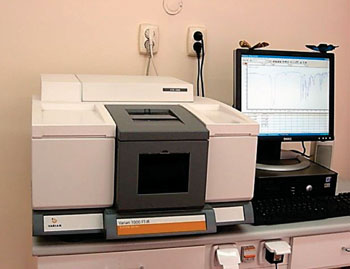Infrared Technology Used To Screen For Minimally Invasive Colitis
By LabMedica International staff writers
Posted on 18 May 2016
Inflammatory bowel diseases, which include ulcerative colitis and Crohn's disease, involve chronic inflammation of all or part of the digestive tract and can lead to life-threatening complications such as colorectal cancer.Posted on 18 May 2016
Assessing this inflammation remains a challenge, and clinical diagnosis is now achieved by colonoscopy, which uses an endoscope or flexible tube with a light and camera attached to examine the digestive tract. This technique is not ideal for an annual checkup or monitoring disease activity regularly because it is expensive, invasive and requires sedation.

Image: The Varian Scimitar Attenuated Total Reflectance Fourier Transform Infrared (ATR-FTIR) spectroscopy instrument (Photo courtesy of S. Levchenkov).
Scientists at Georgia State University (Atlanta, GA, USA) have designed a minimally invasive screening method for ulcerative colitis, a debilitating gastrointestinal tract disorder, using emerging infrared technology which could be a rapid and cost-effective method for detecting disease that eliminates the need for biopsies and intrusive testing of the human body.
The technique involves testing serum, the clear liquid that can be separated from clotted blood, for the increased presence of mannose, a sugar that is a marker for colitis, using Attenuated Total Reflectance Fourier Transform Infrared (ATR-FTIR) spectroscopy. This technology is sensitive to vibrations in the chemical bonds of the serum sample's molecules and requires minimal sample preparation, making it a rapid diagnostic alternative.
In the study, mice in two categories were tested for colitis using ATR-FTIR spectroscopy. The first group was mice with targeted deletion of the interleukin 10 (IL-10) gene, known as interleukin 10 knockout (IL10-/-) mice, which develop colitis through T helper immune cells. Disease in IL10-/- mice closely resembles the physiological, histological and biochemical features of chronic colitis in humans. In the second group of mice, colitis was induced by administering Dextran Sodium Sulphate. Colitis in these mice is similar to ulcerative colitis in humans. In both groups, feces and blood samples were collected and tested. Mice in control groups were also tested. The scientists found ATR-FTIR spectroscopy was an effective tool for detecting colitis in mice serum, showing a significant increase in the levels of mannose, an indicator of colitis.
A. G. Unil Perera, PhD, a professor and senior author of the study, said, “We found that ATR-FTIR spectroscopy is an effective tool for detecting colitis in serum. This rapid, simple, cost-effective and minimally invasive technique could be further developed into a personalized diagnostic tool that would assess disease status based on an individual's molecular composition and allow for personalized diagnosis and drug management.” The study was published on April 20, 2016, in the Journal of Biophotonics.
Related Links:
Georgia State University







 assay.jpg)





